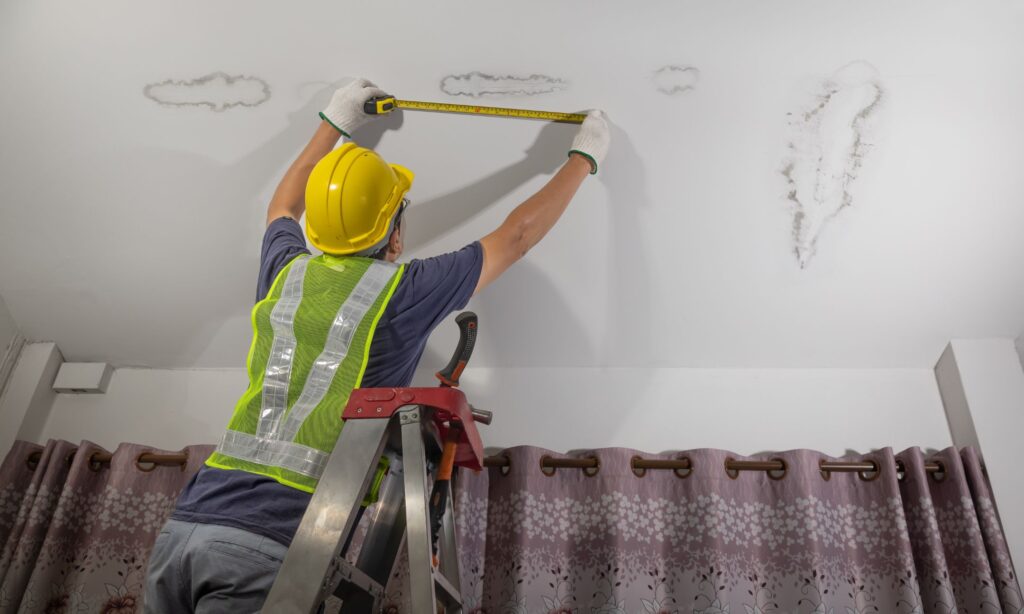Discovering a water stain on your ceiling often signals trouble brewing on the roof above. Once puddles start forming indoors, swift action prevents further damage as the leak is traced and plugged. Flat roofs in particular require prompt fixes before moisture compromises decking and framing integrity.

While permanent roof repairs take planning and ideal dry weather, temporary fixes provide a fast, affordable bandage. We’ll explore five simple DIY methods to stop flat roof leaks in their tracks, plus tips to transition to a lasting solution afterwards.
1: Caulk Small Fissures with Sealant
For narrow splits in roofing material, flexible sealant effectively blocks moisture ingress. After cleaning the crack, apply exterior-grade silicone or acrylic caulk and smooth evenly. Monitor patched spots and reapply more sealant if drips continue. This works for minor cracks in:
- Asphalt (Bitumen)
- Metal
- Single-Ply Membranes
- Built-Up Roofing
However, extensive fracturing warrants fuller repairs. Use sealant strictly as an emergency patch on bigger holes too.
2: Reinforce Vulnerable Areas With Tape
Cover overIsolation vulnerable seams, joints and protrusions prone to loosening. Use flashing tape, repair tape or strips of peel-and-stick membrane matched to your existing roofing. Reinforce:
- Perimeter Edges
- Vent/Pipe Penetrations
- Low Spots Where Puddling Occurs
Built-up overlays help but still allow moisture access to your roof deck. Follow up with more expansive repairs.
3: Apply Roof Coatings to Repel Water
For whole-roof protection without replacing materials, elastomeric roof coatings offer budget-friendly leak prevention. Clean then paint on this thick, reflective barrier allowing superb water resistance as it stretches and seals:
- Cracks
- Seams
- Fastener Points
However, bulky application equipment is cumbersome for DIYers. While helpful for boosting aging roof lifespan at low costs, coatings are more temporary aids, not fixes for existing leaks
READ ALSO: Questions to Ask Before Hiring a Bathroom Remodeling Contractor
4: Install Peel-And-Stick Membrane Patches
For more robust repairs than tape or caulk, custom-cut membrane segments work well. Use self-adhesive flashing or stripped membrane scraps. After cleaning and drying the repair area, outline damaged portions then peel and stick reinforcements on top.
This technique works for most roof types, though prone to peeling or inadequate adhesion if rushed. Allow proper membrane curing based on product guidelines before exposing repairs to ponding water or harsh weather.
5: Try Liquid Leak Sealers
Seeking the ultimate shortcut fix? Fluid-applied leak sealers promise to instantly plug cracks and holes with thick, rubberized coatings. However, blacktop-like textures seem out of place on finished roofs. Many available products lack durability too.
Roofing cement and other goopy emergency leak stoppers seal minor breaches as quicker alternatives to membrane patches. Yet excess thickness can trap moisture, delaying more expansive repairs.
When Are Temporary Flat Roof Repairs OK?

Before relying solely on slapdash patches long-term, consider:
How old is your roof? Past expected lifespan? Time for replacement!
How many leaks exist? Multiple failures signal advanced deterioration.
What caused leaks? Storm damage? Time, decay? Diagnose the source!
What surfaces are affected? Wet insulation and structural damage raise alarms.
For older roofs, severe storms or chronic saturation leak origins, temporary fixes won’t restore watertightness completely. Contact a reputable roofer for quotes on full repairs or replacement.
Get Ahead of Flat Roof Leaks
Don’t resign yourself to perpetually patching unsolved drips. Utilize temporary fixes after first pinpointing breach locations and diameters. Clean, prepare and reinforce compromised areas using methods suited to your existing roofing materials.
Allow adequate drying and curing times before exposing repairs to foot traffic or precipitation. Avoid needless delays arranging professional assistance to prevent bigger headaches. With prompt response, flat roof leaks become minor setbacks rather than catastrophic preludes to ceiling cave-ins or flooded interiors.
FAQs: Common Flat Roof Leaking Repair Questions
Confused what temporary repair method suits your situation? Here are answers to a few frequently asked questions:
What if my flat roof leak worsens overnight?
Heavy precipitation or high winds may worsen existing drips before repairs commence. In an emergency, safely position buckets beneath new breach points. Weigh down tarps over damaged roof sections if possible while arranging contractor visits ASAP. Imminent rain may delay permanent patching, so temporary containment helps in the interim.
How long can temporary flat roof repairs last?
Basic caulking, taping and coatings purchased from hardware stores provide weeks to months of viability at best before needing replacement. More durable flashing-grade repair products used properly endure 1-3 years. But longevity depends on many factors, like roof age, leak extent, precipitation levels and UV exposure. Assume temporary fixes are meant to buy time, not provide permanent resolution.
Is it safe for me to walk on my flat roof?
Exercising extreme caution is mandatory when traversing any roof. Flat designs allow easier mobility but still pose fall hazards if compromise or slippery. Distribute weight using crawling pads when assessing leak damage. Never step into soft, spongy areas indicating waterlogged materials underneath. And always use harnesses, scaffolding and helpers when attempting makeshift roof repairs yourself on tall structures.
How much does it cost to temporarily fix a flat roof leak?
With the right supplies already on hand, rudimentary leak patches can cost less than $20. But sealing larger affected areas requires greater investments in tape, coatings or adhesive membrane sheets around $200-500. Secure problem sites ASAP regardless to prevent exponential damage over time. Compared to roof replacements running $5,000-20,000+, temporary fixes qualify as cost-effective critical care in the interim.
When should I request professional flat roof repair?
While small homeowner-friendly fixes work temporarily, extensive water damage or chronic leakage shortening roof lifespan necessitates professional assistance. Seek licensed contractor assessments for:
- Major ceiling stains spanning 10+ square feet
- Visible sunlight glaring through roof decks
- Large sections of saturated insulation or deformities
- Numerous failure points appearing monthly
Industry experts determine the best combination of repairs, overlays or full roof replacements needed to resolve such scenarios.
In another related article, Hidden Signs Your Home’s Foundation Needs Repair




